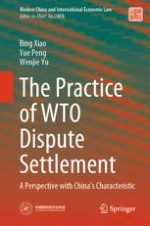2024 | OriginalPaper | Buchkapitel
3. China’s Member Status in WTO Dispute Settlement Practices
verfasst von : Bing Xiao, Yue Peng, Wenjie Yu
Erschienen in: The Practice of WTO Dispute Settlement
Verlag: Springer Nature Singapore
Aktivieren Sie unsere intelligente Suche, um passende Fachinhalte oder Patente zu finden.
Wählen Sie Textabschnitte aus um mit Künstlicher Intelligenz passenden Patente zu finden. powered by
Markieren Sie Textabschnitte, um KI-gestützt weitere passende Inhalte zu finden. powered by
